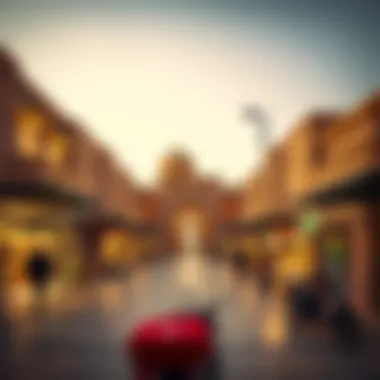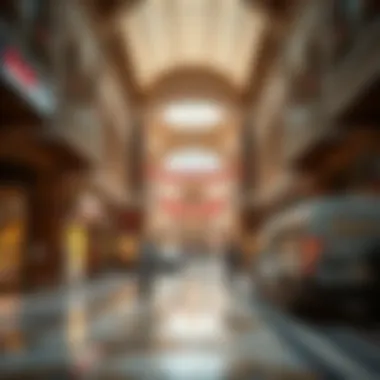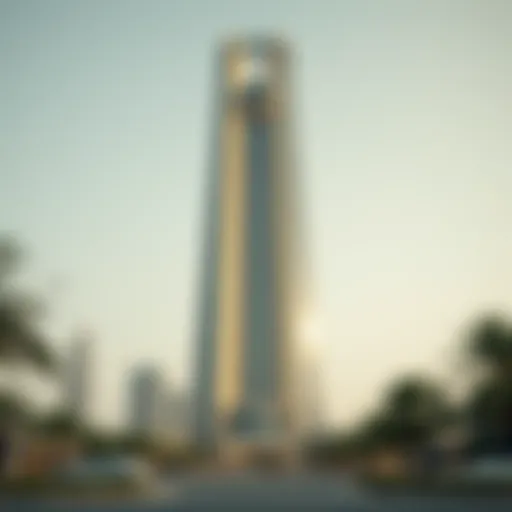Al Falaj Market: Insights into Dubai's Real Estate


Intro
The Al Falaj Market in Dubai is not just a bustling hub for commerce; it plays a pivotal role in shaping the real estate landscape of the city. This region has witnessed a dynamic evolution, reflecting both the heritage and aspirations of the community it serves. Understanding the intricacies of this market is essential for various stakeholders, including homebuyers, investors, and real estate professionals.
This article serves as a comprehensive guide, shedding light on the historical significance, contemporary trends, and investment prospects within Al Falaj. While exploring this vibrant marketplace, it's crucial to consider the different dimensions of the real estate market here. Discussions will encompass market trends, tactical buying and selling strategies, and current investment hotspots that are gaining traction.
Al Falaj, rich in culture and economic potential, offers more than meets the eye. Just like a well-crafted tapestry, its layers of history interweave and contribute to the character of the community. Whether you’re a seasoned investor wanting to expand your portfolio or a first-time buyer looking for that perfect property, navigating this market will need precise knowledge and insight. Let's unravel the layers of Al Falaj Market to see what it has to offer.
Prolusion to Al Falaj Market
Al Falaj Market serves as a significant focal point in Dubai's real estate landscape, touching on various layers of its cultural and economic fabric. For anyone looking to explore real estate opportunities within this vibrant marketplace, it's vital to grasp not just the numbers but the essence of what this market represents. This section sheds light on these nuances and sets the stage for a deeper understanding of Al Falaj's multifaceted identity.
Overview of the Marketplace
Al Falaj Market is more than just a bustling commercial hub; it’s a vivid tapestry that intertwines local traditions with contemporary living. The market is known for its striking architecture, which elegantly blends modern aesthetics with traditional elements. This duality makes it appealing for both investors and individuals seeking an authentic shopping experience.
While most markets can boast about the variety of goods offered, Al Falaj transcends standard expectations. Vendors showcase an array of products ranging from traditional handicrafts to contemporary fashion, making it a one-stop shop for various consumer needs. A visit here is akin to taking a step into Dubai's soul—where every stall holds a story and each corner reflects a piece of the city’s heritage.
For potential buyers and real estate investors, understanding the dynamics of Al Falaj Market can translate into lucrative opportunities. Real estate prices in the vicinity can give insights into market trends, while foot traffic patterns help identify optimal commercial spots. An investor's knowledge of these aspects can lead to informed decisions that align with both personal goals and community needs.
Geographical and Cultural Significance
Nestled in a prime location, Al Falaj Market is not just a physical space; it is a bridge between the past and the present. It sits conveniently close to major roadways and transportation hubs, which amplifies its accessibility and attractiveness for visitors and residents alike. The geographical significance of this area cannot be overstated as it connects various neighborhoods and commercial districts within Dubai.
Culturally, Al Falaj Market embodies a blend of influences—from Emirati heritage to international flavors. It acts as a melting pot where diverse communities come together, thereby enriching the local culture and fostering inclusivity. Whether you’re chatting with vendors or indulging in local delicacies, it’s clear that the spirit of Al Falaj is reflective of Dubai’s broader narrative.
Historical Context of Al Falaj Market
Understanding the historical context of Al Falaj Market is crucial for grasping its significance in Dubai’s ever-evolving real estate environment. The past shapes the present, revealing how this marketplace has not only served as a commercial hub but also as a cultural reference point for the community. So, diving into the roots of Al Falaj, we can better appreciate its current dynamics and potential for the future.
Origins and Development
Al Falaj Market first saw the light of day as a modest trading post in the early 20th century. Initially, it was a gathering place for local merchants and farmers, where they sold fresh produce and handcrafted goods. The marketplace was more than just a bazaar; it embodied the spirit and resilience of the local community.
As Dubai began to transform into a commercial giant, the market evolved alongside. The blend of traditional Middle Eastern architecture with modern designs can still be felt here, creating a unique ambiance where both old-world charm and contemporary style coexist. The layout encourages exploration, with narrow alleys leading to small shops where vendors display their diverse wares.
From its roots, the market has gone through several phases of growth. In the 1980s, with the advent of low-cost housing projects and an influx of expatriates, interest in Al Falaj began to swell. This change brought variety to the market. It became a melting pot of cultures, with vendors hailing from various countries—each contributing their own flavors and products to this vibrant market.
Evolution through the Decades
The market's evolution didn't just stop at expanding its vendor base. Each decade added layers of complexity and character to Al Falaj. In the 1990s, Dubai escalated its marketing efforts, positioning itself as a tourism hotspot. Al Falaj Market became a focal point for visitors, providing a taste of local lifestyles through its bustling shops and eateries.
From then onwards, technological advancements started creeping into the market. The introduction of online platforms and digital payments reshaped how vendors interacted with customers, making transactions quicker and easier. This adaptation was essential for keeping pace with Dubai’s rapid digitalization and the preferences of a younger demographic.
However, this transformation also brought challenges. The influx of mega malls and large retailers in recent years tested the market's resilience. However, Al Falaj has maintained its local charm, accentuating the personal touch that large stores often lack. In many ways, its historical value serves as a defense against contemporary pressures, showcasing why it holds a treasured place in Dubai’s real estate landscape.
"The past is not just what has happened; it is what has shaped us, influenced our present, and forged our path into the future."
Key Features of Al Falaj Market


Exploring Al Falaj Market unveils a tapestry of intricate features that set it apart within Dubai’s evolving real estate landscape. For potential investors, agents, and clients, understanding these elements can pave the way for making informed decisions. This section delves into the architectural highlights, diverse vendor offerings, and community interactions that collectively shape the market's unique character.
Architectural Highlights
The architecture of Al Falaj Market stands out for its blend of modern functionality and traditional craftsmanship. You walk into a visual feast where every corner tells a story. Think of vibrant facades and eye-catching entryways that invite curiosity, drawing you into a world rich with culture. The buildings are designed not just for aesthetics but also for sustainability.
The local architecture often reflects the cultural heritage of the region, with elements like intricate lattice work and bold use of color. These features not just enhance the market’s charm; they embody the history and values of the community. For an investor, the preservation of this architectural integrity can also mean that properties here remain relevant and attractive to a wide audience.
"Architecture in Al Falaj Market is not merely buildings; it's an expression of its soul."
Diverse Vendor Offerings
Diversity is the name of the game at Al Falaj Market. The vendors here represent a melting pot of cultures, bringing a variety of goods and services to the table. From local artisans selling handcrafted goods to tech-savvy retailers offering the latest gadgets, the marketplace caters to every consumer palate.
This vibrancy creates a dynamic shopping experience. Shoppers can find anything from silk scarves to culinary ingredients for cooking traditional dishes. The market’s popularity is fueled by its ability to draw in both locals and tourists alike. As an investor, the range of offerings is a positive indicator; a diverse vendor base signifies resilience in the face of shifting consumer trends.
- Specialty foods that tantalize the taste buds
- Authentic handicrafts that reflect local talents
- Modern boutiques that attract a younger audience
Community Interactions
Community is the heartbeat of Al Falaj Market. It’s not just a place where commerce thrives; it’s where relationships are built. You see residents mingling with visitors, exchanging stories and recommendations. This engagement creates a sense of belonging, making it a favored spot not just for shopping, but for social interactions.
Regular events held in the market attract families and individuals, fostering a vibrant community atmosphere. The welcoming vibe cannot be understated; it encourages repeat visits, which is invaluable for sellers and may lead to stable revenue for property owners. As a savvy investor, tapping into this communal spirit is essential when evaluating potential property investments.
Current Market Dynamics
Understanding the current market dynamics of Al Falaj Market is key for anyone looking to dive into Dubai's real estate waters. This section navigates through relevant trends, buyer and vendor demographics, and economic influences that define the landscape. By grasping these elements, investors, agents, and analysts can make informed decisions that suit their objectives. A fresh perspective on Al Falaj Market can open doors for strategic opportunities.
Recent Trends in Real Estate
In the fast-paced world of real estate, trends often shape buyers' and sellers' choices. Lately, Al Falaj Market has seen a notable shift towards sustainable developments. Eco-friendly buildings in the vicinity are becoming increasingly popular. More people are now looking for properties that offer energy efficiency and green features.
"Sustainability isn't just a buzzword; it's increasingly a prerequisite in today's market."
Moreover, technology is making its mark. Smart homes with integrated systems for security and energy management are stealing the spotlight. This trend caters not only to convenience but also to a growing base of tech-savvy consumers who prioritize innovation alongside traditional comforts.
On a broader scale, been buzzing activity in rental markets. The demand for short-term rentals is rising because it taps into tourism. Investors are keenly looking for properties that can provide steady cash flow through platforms like Airbnb. Thus, staying abreast of these evolving trends proves invaluable for potential investors.
Demographics of Buyers and Vendors
Knowing who the buyers and vendors are in Al Falaj Market can provide insights that go beyond mere statistics. The demographic spreads show a diverse mix of nationalities and cultures, which contributes to a unique market environment. Wealthy expatriates, young professionals, and families looking for homes in Dubai hover around the area.
Buyers from various backgrounds have different expectations and preferences. For instance, expatriates often look for high-end amenities, while local buyers might prioritize family-friendly features. Understanding these distinctions helps realtors tailor their services accordingly.
Vendors also range widely in terms of what they offer – from fresh produce and handcrafted goods to luxury items. This variety attracts diverse customer bases, further enhancing the market's appeal. By identifying these demographic nuances, stakeholders can better strategize their offerings.
Economic Influences
Economically, Al Falaj Market is subject to the ebbs and flows of Dubai's broader market influences. Factors including oil prices, tourism statistics, and global economic health play integral roles. When oil prices drop, there can be a temporary dip in economic activity, which influences real estate demand. Conversely, a rise can encourage investment and increase buyer interest.


Additionally, tourism's impact cannot be overlooked. Dubai's ambition to position itself as a leading tourist destination fosters demand for real estate. A vibrant influx of tourists not only stimulates the hospitality sector but also boosts the residential property market through short-term rental demand.
Local policies and governmental initiatives also come into play. For example, the introduction of new business-friendly regulations can allure investors, leading to an increase in property development. Thus, it's prudent for anyone engaged in Al Falaj Market to keep an ear to the ground regarding economic shifts to better navigate investment opportunities.
By dissecting these three areas within current market dynamics, stakeholders can develop a holistic understanding, maximizing their presence within Al Falaj Market.
Investment Opportunities
In the realm of real estate, identifying lucrative investment opportunities is crucial for both novice and seasoned investors. This section dives into what makes the Al Falaj Market a potential goldmine for various buyers, especially considering the market's historical resilience and geographic advantages. This locale isn't just another property spot – it holds potential that beckons investors looking for both short-term gains and long-term stability.
Residential Investment Potential
The residential segment within the Al Falaj Market has shown remarkable adaptability over the years, reflecting the shifting demands of buyers. Properties here are often seen as a great entry point for first-time homeowners, thanks to competitive pricing and a welcoming community vibe.
Investors keen on residential properties will find a multitude of options, ranging from modest apartments to upscale villas. This diversity attracts different demographics, ensuring a steady stream of demand. Moreover, the proximity to schools, parks, and shopping centers makes these homes appealing – families are always on the lookout for convenient living spaces.
"Investing in residential properties in Al Falaj could mean capitalizing on both returns and community growth."
Engaging in residential real estate here can also prove beneficial due to favorable government policies that encourage home ownership. Various financing options are available, which help lessen the financial burden on buyers. Thus, the residential market in Al Falaj presents an enticing proposition for those looking to invest in a safe and promising environment.
Commercial Property Viability
Commercial real estate in the Al Falaj Market is another area teeming with potential. With the city constantly buzzing with activity, setting up a business here could yield significant returns. This market attracts not just local vendors, but also international brands looking to tap into the Dubai market.
Potential investors will find dynamic opportunities for retail spaces and offices, driven by a growing populace and an influx of tourists. The foot traffic in bustling areas guarantees visibility, which is key for any thriving business. Additionally, the mixed-use nature of developments enables a robust ecosystem where commercial spaces can literally complement residential areas.
When evaluating commercial investments, it’s important to think beyond the immediate profit. Consider the infrastructure and amenities available. Good access to public transport and nearby facilities can significantly affect a business's success. Therefore, smart choices in commercial properties can lead to sustained growth as the area continues to develop.
Long-Term vs. Short-Term Investment Strategies
As an investor in Al Falaj, it's crucial to weigh both long-term and short-term strategies. The choice between these two can often dictate not just the returns you can expect, but also the effort required in managing your investments.
Long-term investments in real estate typically aim for gradual appreciation, especially in promising areas like Al Falaj where neighborhoods are steadily improving. Holding onto properties can yield benefits like increased value over time and rental income stability, leading to a secure financial future.
On the flip side, short-term strategies may be geared towards flipping properties for quick profits. This approach requires a keen eye for market trends and a willingness to invest in renovations to enhance property value swiftly. This method functions well in fast-moving markets, though it does involve more risk.
As Al Falaj continues to evolve and flourish, the investment landscape is sure to become even more attractive.
Challenges in the Market
As any seasoned investor will tell you, understanding the hurdles inherent in a marketplace is as crucial as recognizing its opportunities. In the case of Al Falaj Market, the dynamic landscape is not without its challenges that can significantly impact decision-making processes. These challenges can deter potential investors or, if understood properly, can serve as catalysts for strategic planning. In this section, we will dive into the regulatory framework that governs this marketplace and the saturation issues that might arise.
Regulatory Framework
Navigating the legal and bureaucratic aspects of real estate transactions can often feel like swimming against the tide. In Al Falaj Market, several regulations come into play that shape investor and vendor behavior. The first layer of this framework is established by Dubai’s laws, which vary importantly from those in other global cities.
For instance, foreign investors must navigate a complex system of ownership restrictions and compliance checks. Understanding what these rules entail, such as the need for a local sponsor or implications of property residency status, is crucial before making any moves. The governing documents, such as the Real Estate Regulatory Agency’s guidelines, outline necessary licensing procedures and operational standards that everyone must adhere to.
Some points to consider include:


- Ownership Types: Investers should know the differences between leasehold and freehold properties—this can dramatically affect your investment potential.
- Approval Processes: Familiarity with the approval system can save time and resources. Waiting for permits can feel like watching paint dry, and these delays can alter investor timelines.
- Regulation Updates: Keep an ear to the ground for potential changes in local laws. One wrong turn, and your investment strategy could be thrown out the window.
The importance of these legal frameworks cannot be overstated. Investors who ignore or misunderstand these regulations could find themselves in hot water, facing penalties or worse.
Market Saturation Issues
Another point that investors need to ponder is market saturation. While Al Falaj Market offers plenty of tempting properties, it's essential to take stock of how much inventory is already out there. Over time, the influx of residential and commercial buildings can lead to a buyer's market, driving prices down.
A few things to keep in mind:
- Supply vs. Demand: Watch market movements closely. If there are more properties than buyers, you may end up paying significantly less than expected.
- Competitor Analysis: Knowing who else is in the game—how they price their properties and what unique offerings they have—can give you a leg up in negotiations.
- Investment Timing: Being strategic about when to invest is key. Launching into a market right as saturation peaks can yield lackluster returns.
"In the world of real estate, being prepared for the unexpected can often be the difference between triumph and disaster."
For more information about the rules governing property in Dubai, check out the Dubai Land Department or explore community threads on platforms like reddit.com/r/Dubai.
Future Prospects of Al Falaj Market
As we peer into the crystal ball of Al Falaj Market, the importance of understanding its future prospects cannot be overstated. For investors, real estate agents, and anyone looking to get their foot in the door of this bustling marketplace, grasping the direction the market is headed is crucial. This section aims to dissect the key elements and benefits of the future of Al Falaj Market, shedding light on what stakeholders might expect in the coming years.
Forecasting Trends
Trend forecasting in real estate is as vital as knowing the weather before stepping out of the house. In the case of Al Falaj Market, several factors are shaping its trajectory.
- Technological Integration: New advancements in technology are lighting up the real estate landscape like never before. The integration of smart technology in buildings has led to increased demand. For instance, smart homes with automated systems are becoming the norm, attracting tech-savvy buyers.
- Sustainability Focus: Research is suggesting a growing preference among homebuyers for sustainable and eco-friendly properties. Investors should consider properties within Al Falaj that incorporate green building practices. These types of developments could not only appeal to a more conscious buyer but also offer long-term savings in utilities.
- Cultural Shifts: The demographic landscape is slowly evolving. Younger generations are entering the buyer's market with different tastes and needs. They tend to lean towards mixed-use developments that combine living, shopping, and socializing. A look into Al Falaj's upcoming projects indicates that this trend is being factored into future developments.
In essence, anticipation of these trends creates a roadmap for potential investors and buyers. As the market evolves, aligning investments with forecasted trends can significantly enhance not just transient gains but also secure long-term returns.
Emerging Developments
The pounding heart of Al Falaj Market continues to beat strong with its emerging developments, adding a fresh layer of complexity and opportunity. The local government and private entities are actively engaged in initiatives that promise to reshape the market.
- New Commercial Ventures: There are several upcoming commercial projects that are designed to attract businesses from diverse sectors. These ventures promise to amplify foot traffic and interest in retail spaces, which could greatly enhance the appeal of property investments.
- Residential Complexes: Various residential projects are breaking grounds. Properties that cater to both locals and expatriates are being developed, providing varied options from luxurious villas to affordable apartments. This diversification means there is something for everyone, potentially boosting occupancy rates.
- Infrastructure Improvements: Significant investments are being funneled into infrastructure surrounding Al Falaj Market. New roads, improved public transport systems, and beautification initiatives are not just about aesthetics; they play a critical role in enhancing accessibility, which, invariably, attracts more buyers and increases property values.
"The future of Al Falaj Market is rich with potential. A blend of technology, culture, and fresh development principles will be key drivers for growth."
The End
The conclusion of this comprehensive guide to Al Falaj Market serves as a crucial element, stitching together various insights into a coherent viewpoint for investors, buyers, and real estate professionals. Understanding this marketplace is not just valuable but essential for informed decision-making, as the intricacies of market dynamics can significantly influence future investments.
Recap of Key Insights
In earlier sections, we've traversed the rich history of Al Falaj Market, mapping its evolution and the forces shaping its current landscape. Key points include:
- Historical Significance: The market has stood as a beacon of commerce, reflecting Dubai’s rapid development and cultural diversity.
- Current Trends: Recent shifts show a blend of traditional offerings with modern developments, appealing to a broader demographic.
- Investment Potential: The market presents a variety of opportunities for residential and commercial investments, with potential for growth in specific segments.
These elements highlight that engaging with Al Falaj Market is not merely transactional; it's a gateway to participating in Dubai's broader economic tapestry.
Final Thoughts on Engaging with Al Falaj Market
Engaging with Al Falaj Market involves more than just buying or selling property. It encapsulates understanding the local culture, recognizing the unique offerings, and appreciating the community interactions that define this marketplace. Key considerations include:
- Cultural Sensitivity: Knowing the nuances of buyer preferences tied to cultural backgrounds may aid in targeting marketing efforts.
- Market Research: Continuous assessment of emerging trends will provide a competitive edge, assisting in tailoring investment approaches.
- Building Relationships: Establishing rapport with local vendors and community members can lead to insights and opportunities not available through traditional market analyses.
Investing in Al Falaj Market effectively means being proactive, well-informed, and responsive to both market shifts and community sentiments. The allure of this market lies as much in its potential for prosperity as it does in its rich tapestry of history and culture, offering a unique canvas for those looking to make their mark in Dubai real estate.







